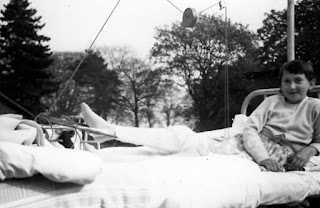My name is Barry Meadley and I was a patient at MH 1944-1947/48.
Having just discovered your website and read all the blogs from former fellow patients, their recollections evoked so many memories. I was diagnosed with TB in my left knee in 1944 and spent a couple of weeks in Leeds General Infirmary then was transferred to Ida hospital at Cookridge, after a couple of months, moving on to MH. I marvel at the memories of some of my contemporaries who can still remember so many names and
incidents with such clarity !
I have no recollection of any names, but can recall some things that are etched in my memory for life. I am pleased to say that 99% of my memories are pleasant and grateful ones. That marvellous moment when you realise you can read and understand without stumbling over the words opened a wide world to a bed bound child, and I could never thank that wonderfully kind and patient lady teacher who enabled me to enter this world enough, Enid Blyton's Sunny Stories spring to mind !
I had my first eyetest at 6 yrs. old, was found to be short sighted, when I got my specs. I remembered being amazed to be able to make out the faces of the kids on the other side of the ward.
I remember a magician coming to give a show, all the beds were pushed together.I was close to the magician and as he pulled a large white rabbit out of a top hat, a photographer from the Yorkshire Evening News took a picture of me reaching out for it. I had a copy of this for years, but it was lost in a house move much to my regret.
It was great when the local hunt would visit on horseback complete with foxhounds. the dogs were so friendly and fussy and I remember one memorable occasion when they got overexcited ran through the ward, matron was not amused! There was one nurse who painted pictures of the huntsmen on old earthenware jamjars she was very talented.
It's funny but you only think that those summers were warm and sunny. being outside in only a splashcloth watching those who could be up splashing around the inflatable rubber dinghy filled with water, kindly loaned by the RAF I believe.
Everyone seems to remember sleeping on the veranda, and that includes me, it does'nt seem to have done any of us any harm. I remember if you were unlucky and were covered by an open weave type cover it was not uncommon to wake up next morning, a bat with it's claws tangled in your bedding! A lot of the nurses shied away from releasing them!!
So much more springs to mind, the Rugby teams visiting after playing at York,conkers from the trees in the drive, playing with the rugby ball bladder in the big boys ward, learning to walk again to name just a few.
Earlier in my story I mentioned that 99% of my memories were pleasant ones, now to the 1% nasty! My hips, left leg and foot were in plaster for the duration of my time at MH, and as I grew, had to be renewed at regular intervals over the years. Unfortunately, now and again, the replacement was left a little late and the cast had become a little tighter than it should have been, which always resulted in what was for a small boy, a very painful and terrifying experience, of course at the time the electric cutting wheel instrument of today did not exist. The plaster cutters of the day resembled the chain and padlock cutters of today, instruments of torture!! I still bear the scars today on my leg and hips, where the plaster cutters took the flesh along with the plaster.
This is the only bad memory I have of my time in MH, I'm sure there must have been others, but at 73 yrs. old, they have faded away long ago. Apart from the obvious dedication of the staff, who will always have my undying gratitude, all my life I have been blessed with infinite patience, this I attribute to my early life spent in MH when we all lived and learned in a cocooned world of our own. Thank you all for stirring up so many memories.
a.jpg)
.jpg)





